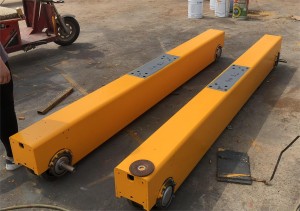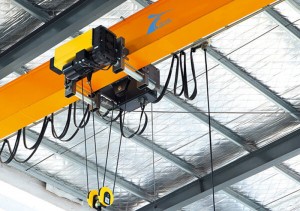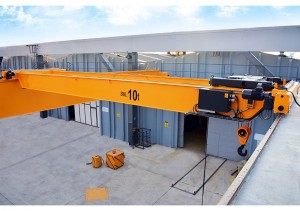
Remote Control Underhung Bridge Crane with Electric Hoist
Product Details and Features
An underhung bridge crane, also known as an under-running bridge crane or underslung bridge crane, is a type of overhead crane that operates on an elevated runway system. Unlike traditional overhead cranes that have the bridge girder running on top of the runway beams, an underhung bridge crane has the bridge girder running beneath the runway beams. Here are some details and features of underhung bridge cranes:
Configuration: Underhung bridge cranes typically consist of a bridge girder, end trucks, hoist/trolley assembly, and a runway system. The bridge girder, which carries the hoist and trolley, is mounted to the bottom flanges of the runway beams.
Runway System: The runway system is mounted on the building structure and provides a path for the crane to travel horizontally. It consists of a pair of parallel runway beams that support the bridge girder. The runway beams are typically suspended from the building structure using hangers or brackets.
Bridge Girder: The bridge girder is the horizontal beam that spans the gap between the runway beams. It moves along the runway system using wheels or rollers mounted on the end trucks. The bridge girder supports the hoist and trolley assembly, which moves along the length of the bridge girder.
Hoist and Trolley Assembly: The hoist and trolley assembly is responsible for lifting and moving loads. It consists of an electric or manual hoist that is mounted on a trolley. The trolley runs along the bridge girder, allowing the hoist to position and transport loads across the workspace.
Flexibility: Underhung bridge cranes offer flexibility in terms of installation and usage. They are often used in facilities where headroom is limited or where existing structures cannot support the weight of a traditional overhead crane. Underhung cranes can be installed in new buildings or retrofitted into existing structures.
Application
Manufacturing Facilities: Underhung cranes are frequently utilized in manufacturing facilities to move raw materials, components, and finished products along assembly lines. They enable efficient and precise positioning of heavy machinery, tools, and equipment during manufacturing processes.
Warehouses and Distribution Centers: Underhung cranes are employed in warehouses and distribution centers to handle and transport goods, pallets, and containers. They facilitate the movement of products within storage areas, loading and unloading trucks, and organizing inventory.
Automotive Industry: Underhung cranes play a crucial role in the automotive industry. They are used for tasks such as lifting and positioning vehicle bodies during assembly, moving heavy automotive parts along production lines, and loading/unloading materials from trucks.
Aerospace Industry: In the aerospace industry, underhung cranes are utilized for the handling and assembly of large aircraft components, such as wings and fuselages. They assist in the precise positioning and movement of these heavy and delicate parts, ensuring efficient production processes.
Metal Fabrication: Underhung cranes are commonly found in metal fabrication facilities. They are used to handle and transport heavy metal sheets, beams, and other structural components. Underhung cranes provide the necessary lifting capacity and maneuverability for various fabrication tasks, including welding, cutting, and forming operations.







Product Process
Underhung overhead cranes find application in a wide range of industries and environments where efficient material handling and lifting operations are required.Their versatility, load capacity, and flexibility make them a valuable asset in numerous industries where efficient material handling and lifting operations are critical.
















